Error!
Oops something went wrong, please try again later.
Oops something went wrong, please try again later.
Your cart is over the maximum shipping weight. Please lower your quantities or contact your local dealer for a direct ship order.
Quantity exceeds the maximum order quantity. The maximum quantity you may purchase is %quantity%.
Quantity is less than minimum order quantity. The minimum quantity you may purchase is %quantity%.
Your cart is over the maximum shipping weight. Please lower your quantities or contact your local dealer for a direct ship order.
Our #FencePro Steven Sarson shows us the difference in breaking strength between high tensile wire and low carbon wire. Compared to low carbon wire, high-tensile barbed wire can withstand 25 to 35% more pressure before breaking. Because high-tensile wire only has 3% elongation, compared to low-carbon wire’s 13% elongation, high-tensile barbed wire doesn’t sag from snow load or when a large livestock pushes up against it.Deciding between high tensile wire and low carbon wire is a matter of what type of fence you are building.
It depends on your long-term goals for your fence. If you want a sturdy and reliable fence, then factors such as breaking strength, flexibility, and longevity matter. The differences between high tensile wire vs. low carbon wire are a few, but vital to note.
Low carbon wire has a carbon content rate of .28 while high tensile wire has a .64 carbon content rate. High tensile wire tends to be lighter yet stronger than wire with lower carbon content.
This means high tensile wire is less likely to elongate or sag than low carbon wire under pressure. High tensile wire has an average breaking strength of 1,500 pounds and a 3% elongation rate. The high tensile wire can handle pressures from animals like cattle and horses.
Also, when working with high tensile wire, installers usually don’t have to stretch the wire by much for the fence to maintain stability, making high tensile wire products a preferrable choice for clients looking for a more durable fence.
If you are just looking for a basic economical fence that does the simple task of protecting your property, then choosing a low-carbon wire product would suffice.
Choosing high tensile wire has several benefits. First, high tensile wire products are less likely to sag and elongate than low carbon options. Due to the wire’s higher carbon content, high tensile fencing products tend to maintain more strength and durability though they are lighter.
It is also easier to install and maintain a high tensile fence. Putting up a high tensile fence takes less posts during the installation process and the lower elongation rate means the fence will require less repairs and maintenance in the future. The quality of high tensile wire can make it worth the investment.
Once set up, high tensile fences can withstand extreme weather and temperature changes throughout the year without sagging or weakening. From our customers’ stories, we find that high tensile fences stand tall despite circumstances. It will not rust or corrode easily thanks to premier coatings used with Bekaert products. A good high tensile fence will spring back to form even when under pressure.
Choosing a quality wire product is an important decision for any fencing project. The difference between high tensile wire and low carbon wire depends on the needs of your fence project.
However, high tensile wire offers a wide range of benefits from added strength to longevity. If quality matters, then high tensile wire may be the way to go.

In this video, Van and Keith from Bekaert Fencing discuss key considerations when selecting fencing for solar projects. As solar installations expand into rural areas, there's a growing shift from traditional chain link to ag-style fencing—a more economical, environmentally friendly, and visually more esthetically pleasing solution. Topics covered include: Benefits of high tensile wire for long-term durability and fewer posts How to design fences that allow small animal inclusion while keeping larger animals out Using Bekaert’s Fencing Calculator to plan your layout, estimate materials, and generate a complete project list Navigating local, state, and federal regulations for solar fencing Whether you're securing a utility-scale solar farm or a smaller installation, Bekaert offers the tools, products, and expertise to help you build a fence that meets your project’s goals. Need help? Use Ask the Fence Pro to get personalized support from our team.
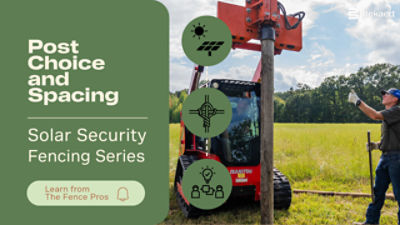
Maximize efficiency and reduce costs with the right post spacing for your solar fencing project. In this video, Bekaert fencing experts Van and Keith break down the advantages of using Solidlock® Pro Fixed Knot fencing over traditional chain link for solar security applications. With post spacing extended to 15–20 feet, Solidlock® allows for fewer posts, faster installation, and significant cost savings—without sacrificing strength or durability. Key topics include: Comparing post spacing requirements: chain link vs. fixed knot fencing Benefits of high tensile wire over low carbon alternatives How Solidlock® eliminates the need for top rails Using the Bekaert fence calculator to estimate materials and layout Accessing bracing specs, installation videos, and expert support Whether you're planning a utility-scale solar farm or a smaller project, Bekaert’s tools and fencing solutions help you build smarter, faster, and more affordably. Need help choosing the right product? Contact us today.
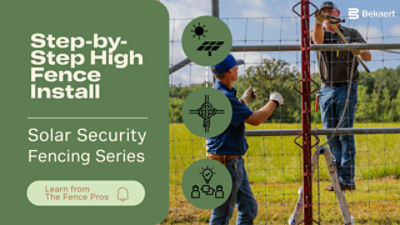
How to Install a High Solar Security Fence with Solidlock® Pro Fixed Knot 1587-6 Looking to install a high solar security or exclusion fence? In this instructional video, we demonstrate how to install Bekaert’s Solidlock® Pro Fixed Knot 1587-6 wire fencing on pipe posts—ideal for securing solar infrastructure, agricultural land, or remote properties. This video picks up after the brace installation videos [wood or pipe] and walks you through: Unrolling and aligning the fence Tensioning the wire to maintain a square, level fit to the terrain Using the right tools for a smooth, professional-grade installation We also showcase the use of a fence roll unwinder from Keystone Fence Supplies—a helpful (but optional) tool that speeds up the process. Tools Featured: Stretcher bars: https://fencing.bekaert.com/en/fence-products/strainrite-103-single-strainer-board-wedge-clamp Stretcher bar pullers: https://fencing.bekaert.com/en/fence-products/strainrite-stretcher-bar-puller-hook-w-chain-boundary-strainer Gripple® T-Clips & wire joiners: https://fencing.bekaert.com/en/fence-products-category/fence-tools-and-accessories/gripple-wire-joiners Knipex wire cutters: https://fencing.bekaert.com/en/fence-products/knipex-8-wire-cutter Bekaert Pipe Post Clips: https://fencing.bekaert.com/en/fence-products/2-3-8-pipe-clips-11-ga-bezinal-400-count-bucket Bekaert drill chuck: https://fencing.bekaert.com/en/fence-products/drill-chuck-for-11-ga-pipe-clips Whether you're a contractor or a DIY installer, this guide ensures your fence is built to last. Need help choosing the right product? Contact us today.
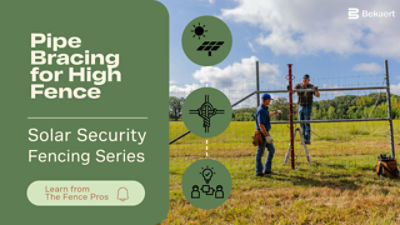
Weld-less Pipe Brace Kits for High/Tall Solar Security & Exclusion Fences Looking for a faster, safer, and more efficient way to build pipe braces for your high solar security or exclusion fence? Our Weld-less Pipe Brace Kits from Bullet Fence, available through Bekaert, are the perfect solution. These innovative kits eliminate the need for welding—reducing fire risk, simplifying installation, and saving valuable time in the field. Designed for durability and ease of use, each kit includes all the components needed to create a strong, professional-grade brace without specialized tools or welding equipment. Whether you're working in remote areas or fire-sensitive zones, these kits offer a reliable and code-compliant alternative to traditional welded braces. Key Benefits: No welding required – safer and faster installation Ideal for all agriculture fencing projects including high/tall solar security and exclusion fences Reduces labor time and complexity Compatible with a variety of pipe sizes Trusted by fencing professionals and landowners alike Upgrade your fence installation process with Bekaert’s weld-less brace solutions—engineered for strength, built for simplicity. Need help choosing the right product? Contact us today.
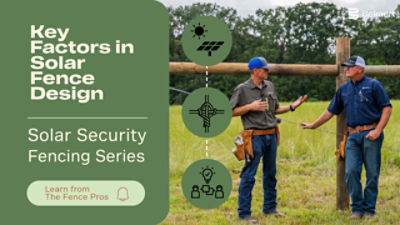
Design smarter solar fencing with Bekaert. In this video, Bekaert experts Van and Keith discuss how to select the right solar security fence to meet your project’s goals—whether it’s protecting solar panels, supporting agrivoltaics, or minimizing environmental impact. Learn how Bekaert’s high tensile fence profiles like the 1584-6, 1775-6, and 1796-6 allow for small animal inclusion, reduce rodent populations, and support grazing strategies for vegetation control. The team also covers how to adapt fence height and layout to meet zoning regulations, and how to enhance protection with smooth wire or barbed wire add-ons. Key features: Wildlife-friendly fence designs Durable, high tensile wire construction Customizable fence heights and spacing Support for agrivoltaics applications Tools like the Fence Calculator, installation videos, and Ask the Fence Pro Need help choosing the right product? Contact us today.
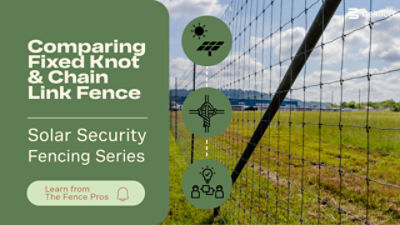
Looking for a better alternative to chain link for your solar fencing project? In this video, Bekaert fencing experts Van and Keith explain why Solidlock® Fixed Knot fencing is a smarter, more cost-effective solution for solar farm security. Compared to traditional chain link, Bekaert’s high tensile ag-style fencing offers: Wider post spacing (15–20 ft vs. 8–10 ft) Lower material and labor costs Stronger, lighter wire for easier handling and installation A more natural, less industrial appearance Long-lasting coatings with up to 40-year guarantees (Bezinal® and Bezinal® + UV Paint) Safer handling for crews and reduced risk of injury Plus, Bekaert provides tools like the Fence Calculator, installation videos, and the Ask the Fence Pro feature to help you plan, spec, and install your solar fencing project with confidence. Need help choosing the right product? Contact us today.
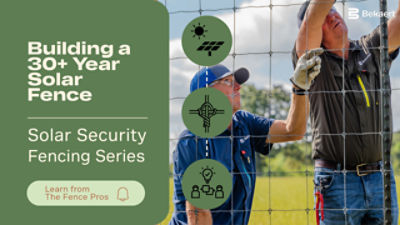
Protect your solar fencing investment with the right coating. In this video, Bekaert experts Keith and Van explain the importance of selecting the right fence coating to match the 20–40 year lifespan of modern solar projects. From Class 1 and Class 3 galvanization to advanced Bezinal® and Bezinal® + UV Paint coatings, Bekaert offers long-lasting solutions engineered for durability in harsh environments—including high heat, humidity, and coastal salt exposure. Key topics include: Coating performance and lifespan: 20, 30, and 40 years How aluminum-zinc coatings like Bezinal® outperform traditional galvanization Aesthetic and protective benefits of UV-resistant black paint Why chain link coatings often fail in rural or corrosive environments How Bekaert’s coatings are backed by industry-leading guarantees Whether you're building in a coastal zone or a dry, sunny region, Bekaert has a coating solution to ensure your fence lasts the life of your solar project. Need help choosing the right product? Contact us today.
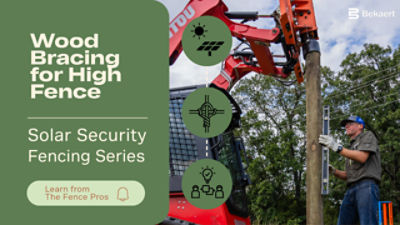
How to Build a Wood Brace for High/Tall Solar Security or Exclusion Fences A properly constructed wood brace is essential for the strength and longevity of any high or tall solar security or exclusion fence. At Bekaert, we provide expert guidance to help you build durable, cost-effective wood braces that support your fencing system in even the most demanding environments. Our step-by-step tutorial walks you through: Selecting the right wood for structural integrity Measuring and cutting for precise fit Assembling a double H-brace maximum support Guidance on getting the right angle of your twitch wire Whether you're fencing agricultural land, solar farms, or remote property, our wood brace guide is designed for both DIYers and professional installers. No welding or special tools required—just proven methods and practical tips to get the job done right. Need help choosing the right product? Contact us today.

We provide advice on selecting high-quality fence posts for your fencing system. The right posts are crucial for fence longevity and stability.
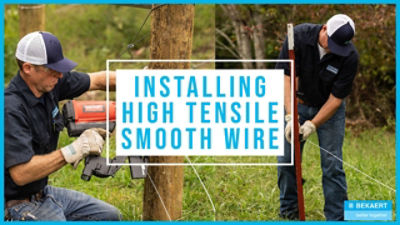
Learn the proper way to install high tensile smooth wire with new and improved processes.